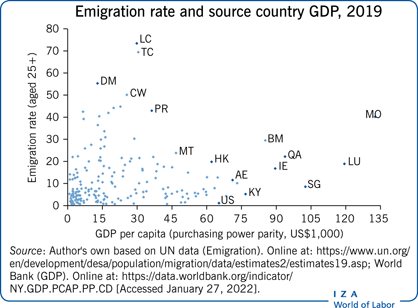Elevator pitch
There are a myriad of economic and non-economic forces behind the decision to migrate. Migrants can be “pushed” out of their home countries due to deteriorating economic conditions or political unrest. Conversely, migrants are often “pulled” into destinations that offer high wages, good health care, strong educational systems, or linguistic proximity. In making their decision, individuals compare the net benefits of migration to the costs. By better understanding what forces affect specific migrant flows (e.g. demographic characteristics, migrant networks, and economic conditions), policymakers can set policy to target (or reduce) certain types of migrants.

Key findings
Pros
Increases in income differentials across countries often lead to increases in migrant flows.
Strong migrant networks have historically played a large role in enhancing migrant flows.
Tax and government transfer policies (e.g. welfare, health care, and educational systems) can attract migrants.
Migration serves as a form of insurance for households and the desire to remit earnings from abroad may form part of the household decision to migrate.
Macroeconomic conditions at home and abroad can affect the flow of migrants.
Cons
Migration costs are central to the migration decision, they take many forms (e.g. transportation, job search, visa fees, smuggler fees), and often vary with distance.
Strict migration policy acts as a constraint in the migration decision.
Demographic factors such as age, education, marital status, and language impact a person’s willingness to migrate.
Worsening political and environmental conditions abroad and/or improving conditions at home can lead to less migration.